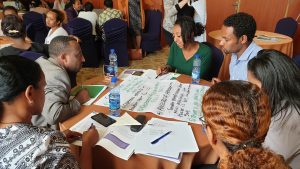Why Obama’s visit wasn’t the only reason for excitement in Kenya this week
The big excitement in Nairobi this week has been President Obama’s impending visit – his first as president. Workers were busy hanging the Stars and Stripes from the lamposts on Thika Road, there were helicopters parked on the lawns of Nairobi and Kenyatta universities, and residents worried that road closures would leave them stranded across the city. As I write this on Friday evening, Air Force One has just landed and the three day visit is finally underway.
But for me Nairobi held a different kind of excitement this week – seeing what some of our partners in Kenya have achieved.
Dr @AumaObama hugs her brother, US President @BarackObama, on his arrival in Kenya on Friday. http://t.co/MM4r1uFG9H pic.twitter.com/9ZluxXJomu
— Daily Nation (@dailynation) July 25, 2015
Enabling research for development in Kenya
I spent much of Thursday with members of Kenya’s national library consortium – KLISC. INASP has been working with partners in Kenya since 2001, and with the group of librarians which came together to form KLISC in 2003. In the wings of a meeting of Kenyan librarians, I spent a couple of hours discussing INASP’s partnership with the KLISC executive committee. It was inspiring to see what they and their members have achieved in recent years. My impression was of a confident and strong leadership, with a clarity of purpose, thinking strategically about the future, and with a real energy to support research in Kenya. KLISC is clear that it has a vital role to play in enabling Kenyan research and teaching, and in doing so to enable this to contribute to national development.
Working with INASP, and with the support of academic publishers, KLISC has enabled Kenyan universities, research institutes, hospitals, think tanks and government agencies to secure access to an impressive collection of online journals and books. It expects its membership to reach 150 in the next year, and is providing some 47,000 journals and 1,200 ebooks free at the point of use to Kenyan academics, students and professionals. It is also providing a programme of training to its members to enable these to be accessed and used.
Relevance and quality
KLISC is acutely aware of the need for research to be relevant to local needs, and making sure research undertaken in Kenya is also a priority. They expect demand for access to Kenyan research to grow, and are supporting their members to develop institutional repositories to ensure it is.
Quality is a big theme in African higher education, and particularly in Kenya where rapid expansion creates new challenges. KLISC has recognised this, and in recent years has also built a strong relationship with the Commission for University Education, Kenya’s regulatory body for the sector. Universities now only receive a charter from government when they can demonstrate they can provide access to a good collection of journals and books to support quality teaching and research. The Kenyan Education Network (KENET) which provides affordable bandwidth and IT support to Kenyan universities and colleges is also a close partner.
Investing in the future
Of course the consortium isn’t without challenges. Kenyan higher education is expanding at an incredible rate, and many of the institutions joining KLISC require a lot of support. Some struggle to contribute their share of funding, lack the expertise or budget to set up the necessary IT facilities, and rely on KLISC to provide training and support. The growth of universities also makes the consortium more complicated to manage.
But KLISC recognises that securing its future requires investing in leadership – particularly the next generation – and demonstrating the value it brings to the institutions who make up its membership. As the executive noted, a strong KLISC will depend on strong member institutions, who are investing in their own library leaders.
While access is good, KLISC are also aware that collections aren’t being used as much as they would like. Its members have successfully engaged students to help improve awareness in the classroom, but KLISC wants to develop new approaches to engaging academics.
KLISC’s achievements might not be generating quite the same buzz as Obama, but when Air Force one has taken to the skies again, KLISC will still be steadily improving the conditions for research and teaching in Kenya – and in turn, its social and economic development.
INASP is also supporting the African Centre for Technology Studies, which is hosting a series of roundtables to bring research evidence into Kenya’s climate change bill and policy process. For more on INASP’s work in Kenya see these latest facts and figures and our Kenya country page.





Sure this was spot on as if God had planned it.
This is a very good summary of the current situation in Kenya that is being felt as a result of the GES. Indeed Kenya has been abuzz with excitement for the last one week due to the GES 2015. This is a huge step for Kenya considering the hardships and bad publicity that we have been through in the last couple of years. As I ponder this congregation and the ongoing discussions, my mind goes to the issues surrounding our work as information scientists and what entrepreneurship/innovations mean for us. For sure as Jon points out, when Airforce one takes back to the skies and each one of the established and budding entrepreneurs goes back to what they know best, what will be the lessons that we will have learnt that can be carried forward to benefit us. What are the good lessons that we as librarians will look back at and say that they were borne at GES 2015??????